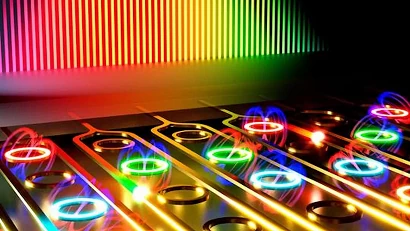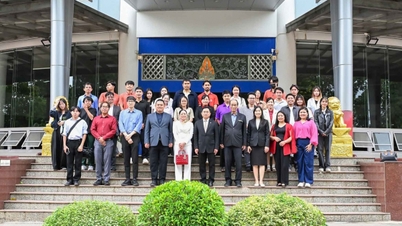US researchers are developing a new type of memory chip that can both store information and perform calculations with high speed and efficiency.
 |
| Researchers say magneto-optical memory chips could help reduce power consumption to free up power for AI. (Source: Live Science) |
This is a new type of ultra-fast memory chip (or memory cell) that uses both optical signals and magnets to efficiently process and store data.
The cells allow users to run high-speed calculations, the team said in the journal Nature Photonics. The faster processing speed and lower energy consumption will help scale data centers for artificial intelligence (AI) systems to work easily.
“Data centers with thousands of graphics processing units (GPUs) require a lot of energy to operate,” said study co-author Nathan Youngblood, an electrical and computer engineer at the University of Pittsburgh. “The solution is often to buy more GPUs and use more energy. So if optics can solve this problem more efficiently and faster, it will reduce the power consumption, and the machine learning system will also operate faster.”
These new memory cells use a magnetic field to steer a light signal clockwise or counterclockwise through a ring resonator, a component that enhances light at certain wavelengths, and sends it to one of two output ports. Depending on the light intensity at each output port, the memory cell can encode a number between 0 and 1, or between 0 and minus 1. Unlike traditional memory cells that only encode 0 or 1 values in a bit of information, the new memory cells can encode a number of non-integer values, allowing for the storage of up to 3.5 bits per memory cell.
Those counterclockwise and clockwise light signals are like “two runners running on the same track, but they're running in opposite directions, with the wind always in front of one and behind the other,” says engineer Youngblood.
The numbers gleaned from this race around the ring resonator can be used to strengthen the connections between nodes in artificial neural networks, helping machine learning algorithms process data in a similar way to the human brain, he said.
Unlike traditional computers, which perform calculations in the central processing unit and then send the results to memory, the new memory cells perform high-speed calculations right inside the memory array. Youngblood said in-memory computing is particularly useful for applications like artificial intelligence that need to process a lot of data very quickly.
The team also demonstrated the durability of this type of magneto-optical memory chip. The researchers said they ran more than 2 billion write and erase cycles on these chips without seeing any degradation in performance, a 1,000-fold improvement over previous memory technologies. Conventional flash drives are limited to 10,000 to 100,000 write and erase cycles, Youngblood said.
In the future, Mr. Youngblood and his colleagues hope to add more of these memory cells to computers and test more advanced calculations.
The technology could help reduce the amount of electricity needed to run artificial intelligence systems, he said.
Source





![[Photo] President of the Cuban National Assembly visits President Ho Chi Minh's Mausoleum](https://vphoto.vietnam.vn/thumb/1200x675/vietnam/resource/IMAGE/2025/10/1/39f1142310fc4dae9e3de4fcc9ac2ed0)
![[Photo] Hanoi morning of October 1: Prolonged flooding, people wade to work](https://vphoto.vietnam.vn/thumb/1200x675/vietnam/resource/IMAGE/2025/10/1/189be28938e3493fa26b2938efa2059e)
![[Photo] Keep your warehouse safe in all situations](https://vphoto.vietnam.vn/thumb/1200x675/vietnam/resource/IMAGE/2025/10/1/3eb4eceafe68497989865e7faa4e4d0e)


























































































Comment (0)